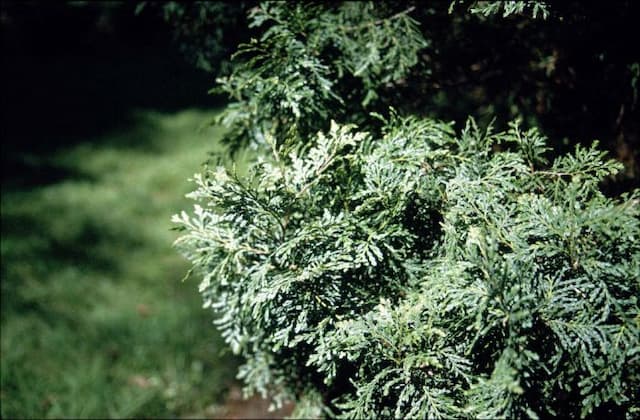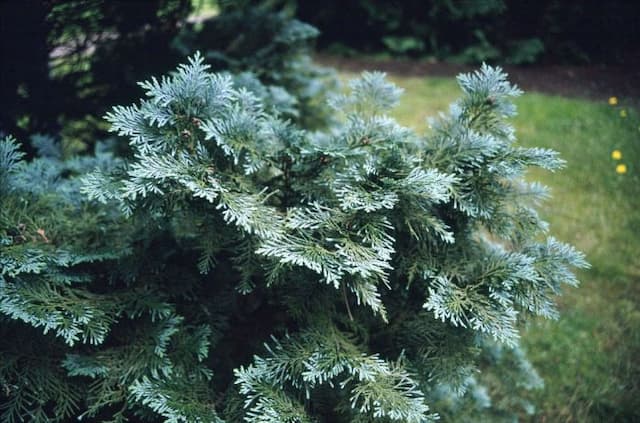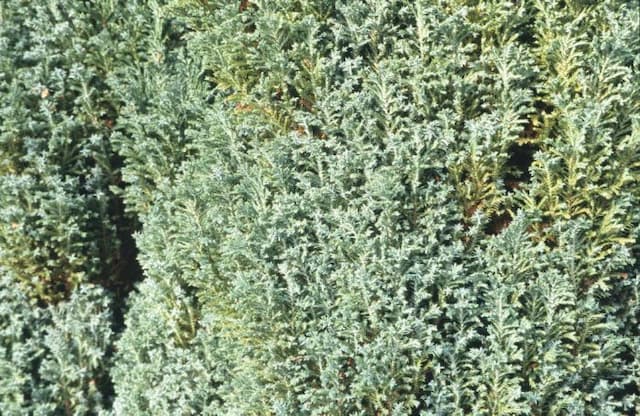Lawson Cypress Chamaecyparis lawsoniana 'Green Globe'











ABOUT
The 'Green Globe' is a cultivated variety of the Lawson cypress known for its distinctive appearance. This plant possesses a unique shape akin to a globe or sphere, which gives it its common name. The foliage is deeply green and lush, creating a dense, textured surface. The needle-like leaves are small and soft to the touch, and they may show subtle hints of blue or silver when caught in the right light, adding to the visual interest of the plant. Its overall form is rounded and compact, making it a popular choice for gardeners looking to add structure to their landscape without the worry of a plant that grows too large. As the 'Green Globe' matures, it maintains its globular shape naturally, often without the need for pruning or shaping.
About this plant
 Names
NamesFamily
Cupressaceae.
Synonyms
Lawson Cypress, Oregon Cedar, Port Orford Cedar.
Common names
Chamaecyparis lawsoniana 'Green Globe'.
 Toxicity
ToxicityTo humans
Port Orford cedar (Chamaecyparis lawsoniana), including the 'Green Globe' variety, is not commonly known to be toxic to humans. However, like many plants, it could potentially cause irritation or an allergic reaction if ingested or if sensitive individuals handle the plant. It is generally recommended to avoid eating any parts of the plant.
To pets
Port Orford cedar (Chamaecyparis lawsoniana), including the 'Green Globe' variety, is not commonly known to be toxic to pets. However, ingestion of non-food plants can sometimes result in gastrointestinal upset such as vomiting or diarrhea in pets. If a pet ingests a considerable amount, it is always a good idea to monitor their behavior and contact a veterinarian if any adverse reactions are observed.
 Characteristics
CharacteristicsLife cycle
Perennials
Foliage type
Evergreen
Color of leaves
Green
Height
3 feet (0.91 meters)
Spread
3 feet (0.91 meters)
Plant type
Shrub
Hardiness zones
5
Native area
North America
Benefits
 General Benefits
General Benefits- Low Maintenance: Requires minimal pruning and care once established, making it an ideal plant for both novice and experienced gardeners.
- Compact Growth: Its naturally rounded shape and dense foliage make it a great choice for smaller gardens or limited spaces.
- Ornamental Appeal: Offers year-round visual interest with its textured foliage and vibrant green color.
- Drought Tolerance: Once established, it has a good resistance to drought, reducing the need for frequent watering.
- Cold Hardy: Can withstand cold temperatures, making it suitable for a variety of climates.
- Pest Resistance: Generally resistant to many common garden pests, minimizing the need for chemical treatments.
- Soil Adaptability: Adapts to a wide range of soil types as long as they are well-draining.
- Privacy Screen: Can be used as a natural privacy screen in landscapes due to its dense growth habit.
- Erosion Control: Its root system can help stabilize the soil and prevent erosion on slopes or in problem areas.
- Wildlife Habitat: Provides shelter and nesting sites for birds and other wildlife.
 Medical Properties
Medical PropertiesThis plant is not used for medical purposes.
 Air-purifying Qualities
Air-purifying QualitiesThis plant is not specifically known for air purifying qualities.
 Other Uses
Other Uses- Miniature Landscaping: 'Green Globe' is often used in miniature and fairy gardens due to its compact growth habit and ornamental appearance, providing a woodland aesthetic.
- Bonsai: Enthusiasts may use 'Green Globe' for bonsai due to its small size and slow growth, making it easier to shape and maintain as a miniature tree.
- Privacy Screens: This plant can be planted in groups to create low, natural privacy screens in gardens or along property lines without growing too tall.
- Topiary Art: 'Green Globe' can be trimmed and shaped into various topiary forms for decorative purposes in gardens or pots.
- Cultural Significance: Some cultures use ornamental plants like 'Green Globe' in ceremonies and festivals to symbolize longevity and strength.
- Photography Props: The attractive, dense foliage of 'Green Globe' makes it a popular choice for photographers seeking natural green backdrops for photo shoots.
- Garden Borders: This plant is suitable for creating well-defined garden borders due to its rounded growth and evergreen nature.
- Themed Gardens: 'Green Globe' can be included in nautical-themed gardens where its globe shape resembles buoys or other maritime elements.
- Educational Tool: In schools or nature programs, 'Green Globe' can be used to teach children about plant growth habits, conifer identification, and garden care.
- Habitat Creation: While primarily ornamental, 'Green Globe' also provides habitat for small wildlife, such as insects and birds, which may nest in its branches.
Interesting Facts
 Feng Shui
Feng ShuiThe Lawson's Cypress 'Green Globe' is not used in Feng Shui practice.
 Zodiac Sign Compitability
Zodiac Sign CompitabilityThe Lawson's Cypress 'Green Globe' is not used in astrology practice.
 Plant Symbolism
Plant Symbolism- Longevity: The Chamaecyparis lawsoniana, commonly known as the Lawson's Cypress, is an evergreen tree, which often symbolizes long life due to its perennial nature. Evergreens often retain their leaves throughout the seasons, representing endurance and the ability to withstand the challenges of time.
- Peace: Lawson's Cypress is known for its calming and serene presence, which can bring a sense of peace and tranquility to a garden. This symbolism is derived from its lush green foliage and soft texture that is often associated with quiet and restful environments.
- Healing: Trees, in general, have been associated with healing due to their medicinal properties and their ability to produce oxygen and cleanse the air. While Lawson's Cypress itself may not have significant medicinal uses, it contributes to the healing symbolism through its role in creating a healthy ecosystem.
- Protection: The dense foliage of the Lawson's Cypress can symbolize protection and shelter. In many cultures, evergreen trees like the Lawson's Cypress are seen as protective beings due to their resiliency and the refuge they provide for wildlife throughout the year.
- Purity: The crisp, green leaves of the Lawson's Cypress can symbolize purity and cleanliness. The color green is often associated with nature, growth, and a fresh start, all of which contribute to the idea of purity.
 Water
WaterThe Lawson Cypress 'Green Globe' requires consistent moisture, but it is essential not to let the soil become soggy as this can lead to root rot. Water the plant deeply once or twice a week, providing about 1 to 2 gallons of water each time, depending on the climate and soil drainage. During hot or dry spells, increase watering frequency to maintain soil moisture. In cooler or rainy periods, reduce the amount of water to prevent oversaturation. Always check the top 2 to 3 inches of soil for dryness before watering to ensure the plant needs additional moisture.
 Light
LightThe Lawson Cypress 'Green Globe' thrives in full sun to partial shade. It prefers a spot that receives at least 4 to 6 hours of direct sunlight daily, with some afternoon shade in hot climates to protect from harsh sunburn. Avoid placing it in deep shade, which would compromise its health and dense foliage.
 Temperature
TemperatureThe Lawson Cypress 'Green Globe' is hardy and can endure temperatures as low as -20°F and as high as 80°F. However, its ideal growing conditions lie within the range of 60°F to 75°F. It's essential to protect the plant from extreme temperature fluctuations and harsh winter winds which can damage the foliage.
 Pruning
PruningThe Lawson Cypress 'Green Globe' generally requires little pruning due to its naturally rounded growth habit. Pruning is typically done to remove broken or dead branches and to maintain its size or shape. The best time for pruning is in the late winter or early spring before new growth starts. Aim to prune sparingly, taking care not to cut back into old wood which may not regenerate.
 Cleaning
CleaningNot needed
 Soil
SoilThe best soil mix for the Lawson's Cypress 'Green Globe' is well-draining, loamy soil with a pH between 5.5 and 7.0. A blend of garden soil, peat moss, and perlite or sand in equal parts can create a suitable environment for its roots.
 Repotting
RepottingLawson's Cypress 'Green Globe' is a slow-growing plant, and typically needs repotting every 3 to 5 years. When the roots begin to circle the inside of the pot or emerge from drainage holes, it's time to repot.
 Humidity & Misting
Humidity & MistingLawson's Cypress 'Green Globe' thrives in moderate to high humidity levels, ideally between 40-70%. It's important to maintain consistent humidity for optimal plant health and growth.
 Suitable locations
Suitable locationsIndoor
Ensure bright light, cool temps, and good air flow for growing indoors.
Outdoor
Provide full sun to partial shade and shelter from strong winds outdoors.
Hardiness zone
5-8 USDA
 Life cycle
Life cycleLawson's Cypress 'Green Globe' starts its life from a seed, which germinates and develops into a seedling under appropriate conditions of warmth and moisture. The seedling then grows into a young plant, experiencing rapid vegetative growth and establishing a root system and foliage. As it matures, 'Green Globe' reaches a more stable phase of growth; it is a dwarf cultivar, so it maintains a relatively compact form and does not become as large as typical Lawson's Cypress trees. This evergreen conifer continues to grow slowly, maintaining its spherical, dense shape and rich green foliage. Throughout its life, it produces cones that carry seeds, completing the reproductive cycle, though propagation is often through cuttings due to its cultivar status. The life span of 'Green Globe' can be many years, but, like all plants, it will eventually succumb to age, environmental stress, or disease.
 Propogation
PropogationPropogation time
Spring-Early Summer
The Chamaecyparis lawsoniana 'Green Globe', commonly known as Lawson's Cypress, is often propagated using the method of semi-hardwood cuttings. The best time to take these cuttings is late summer to early fall. A semi-hardwood cutting is a portion of the current year's growth that has started to mature and harden but is not yet fully woody. For Lawson's Cypress, cuttings of about 4 to 6 inches (10 to 15 centimeters) long are taken from healthy, disease-free branches. Leaves are usually removed from the lower half of the cutting, and the cut end is often dipped in rooting hormone to encourage root development. The cutting is then planted in a well-draining rooting medium and kept in a humid environment until roots have established, which can take several weeks. This method is popular due to its relative simplicity and effectiveness in producing new plants that are true to the parent's form.









